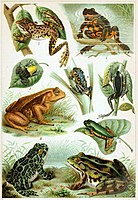
Photo from wikipedia
The widespread African clawed frog (Xenopus laevis) occurs in sympatry with the IUCN Endangered Cape platanna (Xenopus gilli) throughout its entire range in the south-western Cape, South Africa. In order… Click to show full abstract
The widespread African clawed frog (Xenopus laevis) occurs in sympatry with the IUCN Endangered Cape platanna (Xenopus gilli) throughout its entire range in the south-western Cape, South Africa. In order to investigate aspects of the interspecific competition between populations of X. laevis and X. gilli, an assessment of their niche differentiation was conducted through a comprehensive study on food composition and trophic niche structure at two study sites: the Cape of Good Hope (CoGH) and Kleinmond. A total of 399 stomach contents of X. laevis (n = 183) and X. gilli (n = 216) were obtained together with samples of available prey to determine food preferences using the Electivity index (E*), the Simpson’s index of diversity (1 − D), the Shannon index (H′), and the Pianka index (Ojk). Xenopus gilli diet was more diverse than X. laevis, particularly in Kleimond where the Shannon index was nearly double. Both species were found to consume large amounts of tadpoles belonging to different amphibian species, including congeners, with an overall higher incidence of anurophagy than previously recorded. However, X. laevis also feeds on adult X. gilli, thus representing a direct threat for the latter. While trophic niche overlap was 0.5 for the CoGH, it was almost 1 in Kleinmond, suggesting both species utilise highly congruent trophic niches. Further, subdividing the dataset into three size classes revealed overlap to be higher in small frogs in both study sites. Our study underlines the importance of actively controlling X. laevis at sites with X. gilli in order to limit competition and predation, which is vital for conservation of the south-western Cape endemic.
Journal Title: PeerJ
Year Published: 2017
Link to full text (if available)
Share on Social Media: Sign Up to like & get
recommendations!